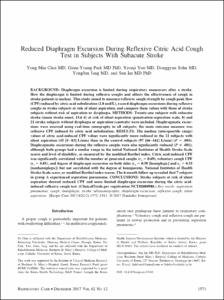KUMEL Repository
1. Journal Papers (연구논문)
1. School of Medicine (의과대학)
Dept. of Rehabilitation Medicine (재활의학)
Reduced Diaphragm Excursion During Reflexive Citric Acid Cough Test in Subjects With Subacute Stroke
- Keimyung Author(s)
- Choi, Yong Min
- Department
- Dept. of Rehabilitation Medicine (재활의학)
- Journal Title
- Respiratory Care
- Issued Date
- 2017
- Volume
- 62
- Issue
- 12
- Keyword
- aspiration pneumonia; cough; diaphragm excursion; hemiplegia; reflexive cough; silent aspiration; stroke; ultrasonography
- Abstract
- BACKGROUND:
Diaphragm excursion is limited during respiratory maneuvers after a stroke. How the diaphragm is limited during reflexive coughs and affects the effectiveness of cough in stroke patients is unclear. This study aimed to measure reflexive cough strength by cough peak flow (CPF) induced by citric acid nebulization (2.8 mol/L), record diaphragm excursions during reflexive coughs in stroke subjects at risk of silent aspiration, and compare these values with those of stroke subjects without risk of aspiration or dysphagia.
METHODS:
Twenty-one subjects with subacute stroke (mean stroke onset, 13.6 d) at risk of silent aspiration (penetration-aspiration scale, 8) and 21 stroke subjects without dysphagia or aspiration (controls) were included. Diaphragmatic excursions were assessed using real-time sonography in all subjects; the main outcome measure was reflexive CPF induced by citric acid nebulization.
RESULTS:
The median (interquartile range) values of citric acid-induced CPF values were significantly more reduced in the 21 subjects with silent aspiration (45 [0-83] L/min) than in the control subjects (97 [66-162] L/min) (P = .004). Diaphragmatic excursions during the reflexive coughs were also significantly reduced (P < .001), although both groups had a similar range in the initial National Institutes of Health Stroke Scale scores and level of disability, as measured by the modified Barthel index. Citric acid-induced CPF was significantly correlated with the number of generated coughs (rs = 0.69), voluntary cough CPF (rs = 0.85), and degree of diaphragm excursion on both sides (rs = 0.50 [hemiplegic] and rs = 0.55 [nonhemiplegic]) but not correlated with the degree of hemiparesis, National Institutes of Health Stroke Scale score, or modified Barthel index scores. The 6-month follow up revealed that 7 subjects in group A experienced aspiration pneumonia.
CONCLUSIONS:
Stroke subjects at risk of silent aspiration showed reduced CPF and more limited diaphragm excursion during the citric acid-induced reflexive cough test.
- Keimyung Author(s)(Kor)
- 최용민
- Publisher
- School of Medicine (의과대학)
- Citation
- Yong-Min Choi et al. (2017). Reduced Diaphragm Excursion During Reflexive Citric Acid Cough Test in Subjects With Subacute Stroke. Respiratory Care, 62(12), 1571–1581. doi: 10.4187/respcare.05488
- Type
- Article
- ISSN
- 0020-1324
- Appears in Collections:
- 1. School of Medicine (의과대학) > Dept. of Rehabilitation Medicine (재활의학)
- 파일 목록
-
-
Download
 oak-2018-0926.pdf
기타 데이터 / 687.8 kB / Adobe PDF
oak-2018-0926.pdf
기타 데이터 / 687.8 kB / Adobe PDF
-
Items in Repository are protected by copyright, with all rights reserved, unless otherwise indicated.